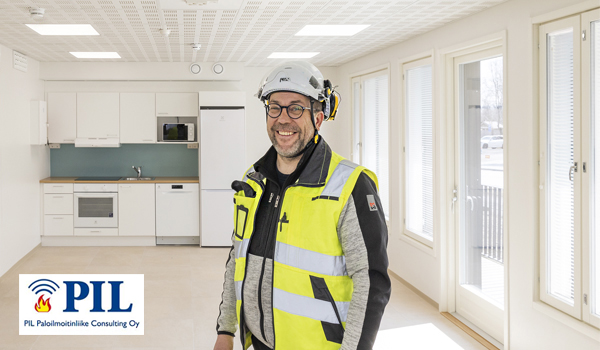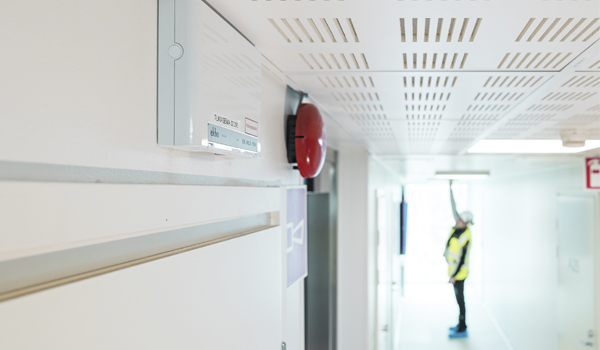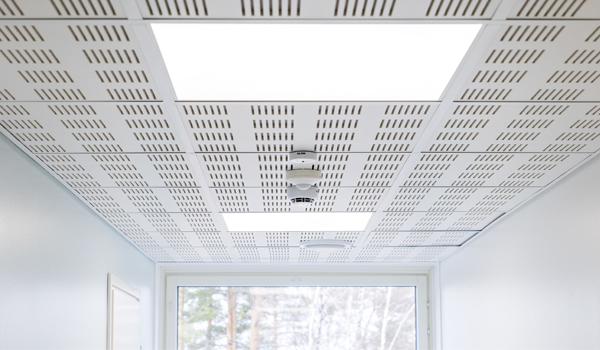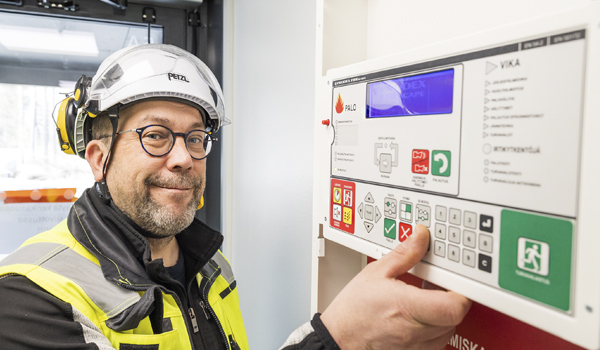For its student residence building, Luovi Vocational College in Joensuu wanted a high-quality fire alarm system that could be quickly installed. The college chose the Prodex FIREscape hybrid solution, which uses wireless detectors. It was installed in a matter of days without disruptions to other goings-on at the college. An added bonus was that it could also be installed without making any marks on the building’s newly completed surfaces.
Luovi Vocational College in Joensuu, which provides vocational special needs education and training for young people, is based in the Karsikko district. The college’s new campus development project began in May 2022, but ran into delays as the contractor was forced into corporate debt restructuring.
The six-floor student residence building and the college building, with learning space for around 200 students, were completed in the spring of 2024. Due to the debt restructuring, however, changes had to be made to how the remaining work was organised. One of the most urgent parts of this remaining work was the design and installation of a fire alarm system for the student residence building.

An industry expert specialising in fire alarm installations, PIL Paloilmoitinliike Consulting, was chosen as the contractor. The client, the Organisation for Respiratory Health in Finland, wanted a high-quality system that would be fit for a student residence and would last for years. It also had to have clear and effective emergency lighting guidance. In addition, the installation phase had to involve minimise disturbance, using wireless fire detectors that required no visible cabling or protective mouldings.
A hybrid system
The decision on the right system was quickly made. Hedengren Security’s Prodex FIREscape fire emergency lighting system provided the most efficient and safest fire safety light guidance solution. Hedengren’s system could be installed in hybrid form, meaning that it consisted of both wireless and traditional fire detectors.

“Hedengren Security is one of our largest clients, we have always worked very well together. Their systems are very high-quality and you can always count on their security of supply. When you order a system from a Finnish company, there’s always the added bonus of technical support being close by, with a contact person you can reach quickly,” says Paloilmoitinliike PIL Consulting project manager Mika Miettinen, who has been involved with projects with Hedengren Security for over 30 years.
Approximately 80 wireless fire detectors and five base stations were ordered from Hedengren Security. As this was the contractor’s first time installing and programming Hedengren Security’s wireless sensors, they decided to review the plans for programming and the locations of the base stations with Hedengren Security specialists beforehand.

Simple and straightforward installation
It took two technicians just two days to programme the system, install the wireless detectors and activate the whole system. The conventional, non-wireless detectors were installed by another party prior to this work, mostly in corridors, storage spaces, communal laundry rooms, and engineering and utility services rooms. In these locations, the technicians were able to hide the cables above suspended ceilings.
According to the project manager, Hedengren’s hybrid solution was straightforward and easy to install.

“We have used other systems in the past, and I was surprised by how straightforward Hedengren’s hybrid system was. The status and signal strength of every detector could be viewed at the base stations, so the technicians didn’t have to find and check every detector one by one. It was easy to find good locations for the base stations and to see if signals were blocked by any building structures”, Miettinen says.
Hedengren Security’s contact person for the project, Pekka Kukkola, says the contractor is also to thank for the smooth installation process.
“PIL Paloilmoitinliike is a long-term partner and knows the Prodex system well. They had also prepared the programming and installation plans meticulously. It was great to see how skilfully and quickly they were able to complete such a large-scale project,” Kukkola says.

A cost-efficient solution
According to Kukkola, the use of wireless fire detectors used to be limited by their poor availability.
“Now that there are enough products on the market, I think hybrid solutions will very quickly become much more common. Wireless detectors have previously been used mainly in conserved buildings and sites with architecture that imposed a lot of demands.”

Kukkola considers wireless detectors especially convenient, since they allow for disturbance-free installation that conforms to the architecture of the site. The detectors also speed up commissioning and are cost-effective.
“Even though wireless detectors are slightly pricier than conventional ones, the total project price is usually actually lower thanks to the substantial savings in installation and cabling material costs. And of course, the more complicated and laborious the cabling arrangements would have been, the greater the savings,” says Kukkola.
A good fit for renovations
The fact that wireless fire detectors are battery-powered often made buyers hesitant, but Kukkola says this is no longer a factor.
“Modern batteries last between 8 and 10 years, and the systems are self-diagnostic – they give a warning when the power is starting to run out. Each smart fire detector also has its own, unique address, which provides comprehensive data on the status of each detector and makes it easy to pinpoint the ones that need new batteries.”

Hedengren’s key account manager recommends wireless solutions especially for renovation projects and buildings where the installation must be carried out with either no disturbance to everyday activities or otherwise unobtrusively.
Kukkola also considers wireless solutions to be a good option for buildings with thick walls, as these can be hard to penetrate as needed for the installation or conventional systems. They are also a good alternative for large construction sites, as the detectors can be moved from one space to another as work progresses.
Prodex FIREscape: a hybrid solution
- Prodex FIREscape is the world’s safest integrated fire safety lighting system, and can be installed with both wireless and traditional fire detectors.
- With the status and signal levels of all the detectors in the system being visible in a single view, the system is easy to program and map out.
- Wireless detectors allow for fast, disturbance-free installation.
- The hybrid system is often a more cost-effective solution, since wireless detectors reduce labour and material costs.
- The hybrid model makes it possible to install the system without any harm to the building’s architecture. Conventional fire detectors can be used where there are suspended ceilings to conceal the cabling, whereas the more discreet wireless detectors are a better fit for other areas.
- Wireless detectors have a very long battery life (between 8 and 10 years), and their self-diagnostic system alerts users in good time when the batteries must be changed.
- Hybrid systems are the perfect fit for projects with a tight schedule and buildings that are in continuous use.
- They are also good for renovations and protected buildings. The system also provides benefits for fireproofing of construction sites, where the wireless detectors can be moved as the work progresses, and buildings with thick walls, where it would be difficult to insert cabling.
- Hedengren offers contractors continuous training and product support.